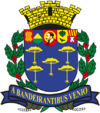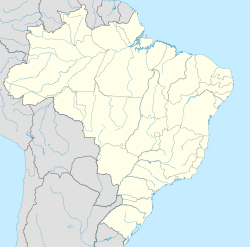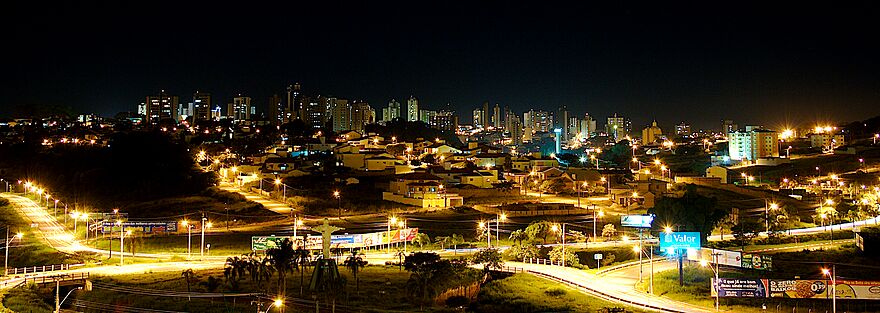São Carlos facts for kids
Quick facts for kids
São Carlos
|
|||
|---|---|---|---|
|
Municipality
|
|||
| Municipality of São Carlos | |||
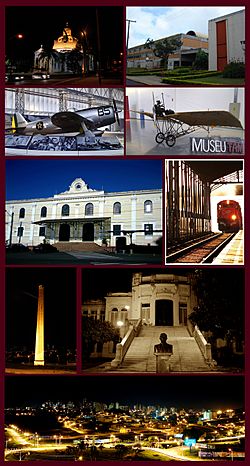
Views of São Carlos, Top left:Night view of São Carlos Cathedral, Top right:Federal University of São Carlos, 2nd:Planes display in Wings of a Dream Museum, P-47D Thunderbolt(left), Santos Dumont Demoiselle(right), Middle:São Carlos railroad station, Entrance Building(left), track and platform(right), 4th left:Chamine Garden, 4th right:Alvaro Guiao School, Bottom:Night view of Downtown São Carlos from Iguatemi Shopping Mall
|
|||
|
|||
| Nickname(s):
The Capital of Technology,
Weather City and Sanca |
|||
| Motto(s): | |||
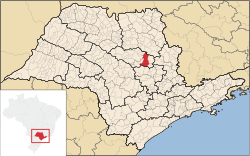
Location in the São Paulo state.
|
|||
| Country | |||
| Region | Southeast | ||
| State | |||
| Founded | 4 November 1857 | ||
| Incorporated | 1880 | ||
| Area | |||
| • Municipality | 1,136.907 km2 (438.962 sq mi) | ||
| • Urban | 67.25 km2 (25.97 sq mi) | ||
| Elevation | 856 m (2,808.4 ft) | ||
| Population
(2020)
|
|||
| • Municipality | 254,484 | ||
| • Density | 216.45/km2 (560.6/sq mi) | ||
| Time zone | UTC-3 (UTC-3) | ||
| • Summer (DST) | UTC-2 (UTC-2) | ||
| Website | saocarlos.sp.gov.br – São Carlos' Prefecture | ||
| HDI (2000) 0.841 – high | |||
São Carlos is a city in Brazil, located in the state of São Paulo. Its name means "Saint Charles" in English, named after Saint Charles Borromeo. The city is about 254 kilometers (158 miles) from the big city of São Paulo.
São Carlos has a population of over 254,000 people. This makes it the 13th largest city in São Paulo state. It is also very close to the center of the state. The city includes its main area and four smaller districts: Água Vermelha, Bela Vista São-Carlense, Santa Eudóxia, and Vila Nery.
This city is a major center for industry and farming. It produces sugar cane, oranges, milk, and chicken. Many international companies have factories here. São Carlos also has many shops and a large mall. It is known for its research and universities. In fact, São Carlos has more people with PhDs per person than any other city in South America! There is one PhD for every 135 people.
São Carlos is home to several important public universities. These include the Federal University of São Carlos (UFSCar) and two campuses of the University of São Paulo (USP). There are also the Federal Institute of São Paulo (IFSP) and FATEC. Because of these schools, many students from other cities and states live in São Carlos.
Contents
History of São Carlos
The São Carlos area began to be settled in the late 1700s. This happened when a new road opened to gold mines in other states. People from Piracicaba and Rio Claro traveled through the hills and fields. They settled in this region. The history of São Carlos officially started in 1831. This is when the "Pinhal" (Pines) land was marked out.
On November 4, 1857, São Carlos was founded. Most people lived in houses around a small church. They were mainly the family of Arruda Botelho, who owned the "Pinhal" lands. Between 1831 and 1857, the first coffee farms were created. Coffee became the city's first main business. By 1840, coffee crops were growing all over the fertile lands. They became the most important product to export. Antônio Carlos de Arruda Botelho, Count of Pinhal, a rich farmer, is known for founding the city.
São Carlos became a village in 1865. A ruling council was set up. By 1874, the village had almost 7,000 people. This showed how fast it was growing. It became a city in 1880. By 1886, with over 16,000 people, its city structure was well-established.
The city grew a lot because of coffee farming. This was especially true from the late 1800s to the early 1900s. In 1884, a railway arrived. This made it easy to transport coffee to the Santos harbor. The railway also helped the city center become stronger.
When slavery ended, the government encouraged immigrants to come. São Carlos had already welcomed German people in 1876. From 1880 to 1904, São Carlos was a major place for immigrants in São Paulo state. Most of them were Italians, especially from Northern Italy. They worked on coffee farms, in factories, and in trade.
In the early 1900s, many cultural groups formed. They helped people learn to read and write. The Vittorio Emanuele Society (1900) and Dante Alighieri (1902) were some of these groups. The Italian community was so large that the Italian government had a consulate office in São Carlos for many years.
After the Wall Street crash of 1929, coffee farming faced problems. Many immigrants left the farms. They started working in factories, making wood items, pottery, and in construction.
Farmers had used their coffee profits to start other businesses in São Carlos. These included banks, electricity, cable cars, telephones, and hospitals. This helped the city become ready for industry. From the 1930s to the 1940s, skilled workers from other cities arrived. They helped make industry the main business in São Carlos. The city's industry was strongest in the 1950s. São Carlos became an important manufacturing center in São Paulo state.
Workshops that supported the coffee industry also grew. Making machines for processing coffee, shoes, and furniture expanded the economy in the 1930s. In the 1950s and 1960s, new factories for machines and tractors opened. Many small and medium-sized companies also started.
In the second half of the 1900s, São Carlos became a hub for technology and higher education. The Engineering School of the University of São Paulo was created in 1953. In the 1970s, the Federal University of São Carlos also opened.
Geography and Environment
São Carlos is in the middle of São Paulo state. It is about 231 kilometers (144 miles) from the city of São Paulo. The city is the center of a larger area with over 308,000 people.
The city is located at an altitude of over 856 meters (2,808 feet). Most of the year, it is windy and sunny. Temperatures are generally warm throughout the year.
São Carlos covers a total area of about 1,141 square kilometers (441 square miles). This area includes four districts. Two are to the north (Santa Eudóxia and Água Vermelha). One is to the west (Bela Vista São-carlense). And one is to the east (Vila Nery).
Nature and Trees
The original plants in São Carlos included cerrado (a type of savanna) and Atlantic Forest. Today, much of this natural plant life has been replaced by farms and tree plantations.
In 2020 and 2021, São Carlos was recognized by the "Tree Cities of the World" program. This program is run by the United Nations. It celebrates cities that plan and manage their urban forests well.
Waterways
São Carlos has several rivers and streams. The main urban area is located near the Monjolinho River. Other important rivers include the Gregório and Santa Maria do Leme. Many smaller streams also flow through the city.
Some areas along the rivers in the city have been built on. This can sometimes lead to floods in lower parts of the city.
Climate of São Carlos
São Carlos has a tropical climate. This means it has a dry winter and hot months.
Since 1961, the lowest temperature recorded in São Carlos was 0.9°C (33.6°F) on July 17, 2000. The highest temperature was 38.7°C (101.7°F) on October 7, 2020. The most rain in one day was 143.1 millimeters (5.6 inches) on February 13, 1980.
| Climate data for São Carlos (1991–2020) | |||||||||||||
|---|---|---|---|---|---|---|---|---|---|---|---|---|---|
| Month | Jan | Feb | Mar | Apr | May | Jun | Jul | Aug | Sep | Oct | Nov | Dec | Year |
| Record high °C (°F) | 36.3 (97.3) |
36.6 (97.9) |
36.0 (96.8) |
35.0 (95.0) |
32.0 (89.6) |
30.0 (86.0) |
31.0 (87.8) |
35.0 (95.0) |
38.0 (100.4) |
38.7 (101.7) |
36.9 (98.4) |
36.0 (96.8) |
38.7 (101.7) |
| Mean daily maximum °C (°F) | 28.5 (83.3) |
28.9 (84.0) |
28.3 (82.9) |
27.5 (81.5) |
24.8 (76.6) |
24.4 (75.9) |
24.7 (76.5) |
26.8 (80.2) |
28.2 (82.8) |
28.9 (84.0) |
28.5 (83.3) |
28.6 (83.5) |
27.3 (81.1) |
| Mean daily minimum °C (°F) | 19.0 (66.2) |
19.0 (66.2) |
18.4 (65.1) |
16.6 (61.9) |
13.6 (56.5) |
12.6 (54.7) |
12.3 (54.1) |
13.5 (56.3) |
15.4 (59.7) |
17.2 (63.0) |
17.6 (63.7) |
18.5 (65.3) |
16.1 (61.0) |
| Record low °C (°F) | 9.0 (48.2) |
9.0 (48.2) |
7.0 (44.6) |
6.9 (44.4) |
4.5 (40.1) |
2.2 (36.0) |
0.9 (33.6) |
3.2 (37.8) |
4.8 (40.6) |
6.2 (43.2) |
7.0 (44.6) |
9.0 (48.2) |
0.9 (33.6) |
| Average precipitation mm (inches) | 297.2 (11.70) |
216.6 (8.53) |
174.9 (6.89) |
79.3 (3.12) |
59.9 (2.36) |
38.2 (1.50) |
30.0 (1.18) |
22.5 (0.89) |
65.4 (2.57) |
116.2 (4.57) |
158.9 (6.26) |
233.2 (9.18) |
1,492.3 (58.75) |
| Average precipitation days (≥ 1.0 mm) | 15 | 13 | 9 | 4 | 4 | 1 | 1 | 1 | 4 | 6 | 9 | 14 | 81 |
| Average relative humidity (%) | 75.0 | 74.0 | 72.0 | 67.0 | 67.0 | 64.0 | 61.0 | 50.0 | 53.0 | 60.0 | 66.0 | 71.0 | 65.0 |
| Mean monthly sunshine hours | 243.7 | 228.4 | 286.2 | 242.2 | 219.1 | 208.9 | 232.3 | 242.0 | 211.4 | 215.9 | 221.2 | 240.3 | 2,809 |
| Source: Instituto Nacional de Meteorologia (precipitation days, humidity and sun 1981–2010) | |||||||||||||
Economy and Industry
São Carlos has a strong industrial economy. It is home to important national and international companies. Farming is also important, thanks to new technologies developed by Embrapa, a research company with two centers in the city. In 2011, the Brazilian President called São Carlos "The National Capital of Technology."
The city has many local technology companies, like Opto Eletrônicos. It also has factories for big international companies such as Faber Castell, Electrolux, and Husqvarna. Volkswagen also has an engine plant here. Brazilian companies like TAM MRO – Technology Center are also present.
Most of São Carlos's money comes from services and trade. This makes up about 65.9% of the city's total economy. Industry is also very important, making up 32.3% of the economy. Farming is a smaller part, at 1.7%.
Culture and Education

São Carlos is a major center for learning in Brazil. It has two campuses of the University of São Paulo (USP) and the Federal University of São Carlos (UFSCar). These are two of the most important higher education centers in the country. There is also a private university, UNICEP, and community colleges like SENAI and SESC.
Because of all these schools, São Carlos is known as a "university town." It has many businesses that cater to students. The city is also famous for its student parties.
São Carlos has a lively cultural scene. Young people enjoy concerts by Brazilian artists who often visit the city. There are also three theaters and seven movie theaters.
Two big events happen every year. The Climate Party is in April. It includes an Orchid Exposition with crafts and food. An Oktobertech festival is also held each year, along with the São Carlos High Tech Fair (Fealtec).
The TAM Airlines Wings of a Dream Museum (Museu TAM) used to be in São Carlos. It was about 15 kilometers (9 miles) from the city center.
Transportation in São Carlos
Roads
- SP-310 – This road, called Rodovia Washington Luís, goes 244 km (152 miles) to São Paulo.
- SP-318 – This road, called Rodovia Eng. Thales de Lorena Peixoto Junior, goes 116 km (72 miles) to Ribeirão Preto.
- SP-215 – This road includes Rodovia Luís Augusto de Oliveira and Rodovia Dr. Paulo Lauro e Dep. Vicente Botta.
Air Travel
São Carlos has the Mário Pereira Lopes International Airport. This airport is home to one of TAM Airlines' maintenance bases. The air and space TAM Museum was also located here. The closest major airport with regular flights is Ribeirão Preto Airport, about 90 km (56 miles) away.
Notable People from São Carlos
Many famous people were born in São Carlos:
- Fábio Aurélio, a former football player for Liverpool F.C.
- Nenê, a former NBA basketball player.
- Maurren Maggi, a track and field athlete who won a gold medal at the 2008 Summer Olympics.
- Ronald Golias, a famous actor and comedian.
- Izabel Goulart, a supermodel.
- Felipe El Debs, a Brazilian chess Grandmaster.
Sister Cities
São Carlos has "sister city" relationships with other cities around the world:
- Coimbra, Portugal (since 1970)
- Tecumseh, Michigan, United States (since 1997)
- Santa Clara, Cuba (since 2005)
- Santa Cruz, Rio Grande do Norte, Brazil
See also
 In Spanish: São Carlos para niños
In Spanish: São Carlos para niños



